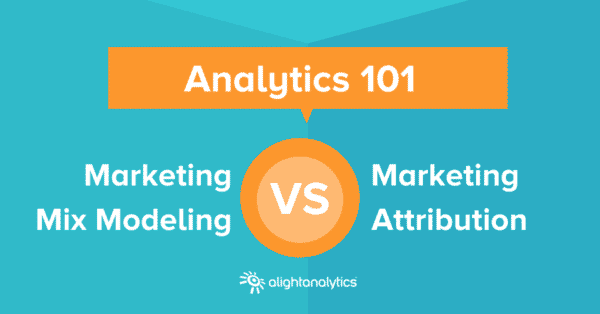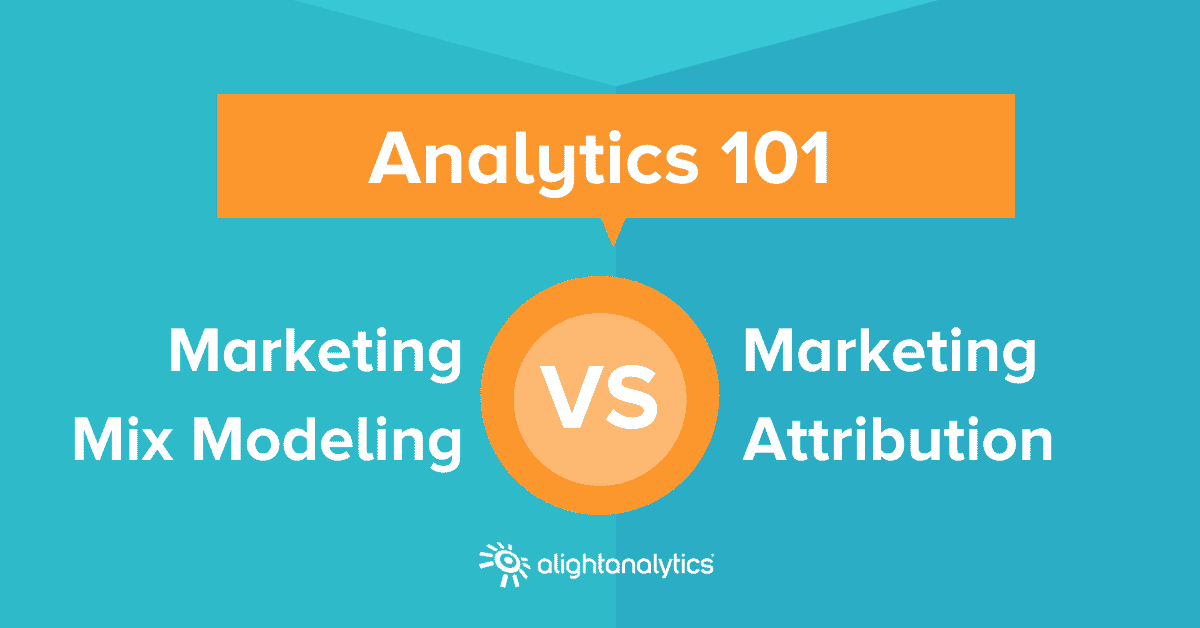
At first glance, marketing mix modeling and marketing attribution look like they have a lot in common.
They’re both trying to help marketers determine what strategies or tactics are creating results, so they can spend more time and money on what really works.
But MMM and attribution modeling approach this question in two very different ways, and they each offer different benefits for marketers who need to plan and optimize their campaigns.
It’s important to understand those differences so you can use the form of analysis at the right time.
How Does Marketing Mix Modeling Work?
Marketing mix models — also known as media mix models — are a top-down form of analysis.
Using regression analysis, a marketing mix model can determine how multiple inputs (such as marketing spend, impressions generated by channel, seasonality, brand reputation and more) correlate to a single output such as leads, revenue or sales over a given period of time.
We spent $1 million on advertising during the first half of the year and ended up with $3 million in sales.
That’s a very simplified example, of course. In reality, a marketing mix model will analyze the effect of multiple variables, in isolation and together.
When we stopped using direct mail, sales dropped 50 percent. When we used direct mail and TV at the same time, sales were 20 percent higher.
Alight uses a machine learning model, an algorithm that looks for relationships between multiple variables. Because it’s automated, the model can process extremely large amounts of data very quickly and uncover patterns faster than an entire team of human analysts could.
When to Use Marketing Mix Models
Marketing mix modeling is useful for planning campaigns and forecasting their performance.
Once the model has determined the relationship between inputs and output, it’s possible to extrapolate what could happen in the future. Here at Alight, we built a calculator that lets you test different levels of spending and predict what could result.
If you know that historically every $1 spent on paid search leads to $3 in revenue, then you can predict that a $1 million budget would generate $3 million in revenue.
And that’s a simplified example, too. Your model should allow you to test multiple combinations of channels at multiple levels of spend.
What if you spent $100,000 on search, $200,000 on social and $250,000 on direct mail? A media mix model can tell you what could occur.
Marketing mix modeling is especially helpful for campaigns that include both online and offline media. It’s more difficult to use offline media in marketing attribution.
What Are the Limitations of Marketing Mix Models?
These types of models need large amounts of historical data in order to work — anywhere from 18 to 24 months to start. Because of this reliance on historical data, MMM usually won’t be a good fit for brand new products.
Marketing mix models also operate on the assumption that future conditions will basically resemble the recent past.
So if you were operating in a period of great uncertainty, like the early days of the COVID-19 pandemic, a marketing mix model probably wouldn’t have produced accurate forecasts.
eBook: The Marketer’s No-Nonsense Guide to Marketing Attribution
How Does Marketing Attribution Modeling Work?
If marketing mix modeling is top-down, then marketing attribution is bottom-up.
That’s because an attribution model runs on user-level interactions — the kind that digital analytics is good at measuring.
An attribution model will look at which marketing messages, channels and campaigns your customers encountered (and in what order) before converting. (Assuming there’s some kind of tracking system in place.)
The model can then determine how much credit each one deserves for a conversion.
This is a much more granular approach than marketing mix modeling, which really only needs to know the big picture numbers, like how much was spent on marketing and what the results were.
A marketing mix model doesn’t want to know which ads your audience saw before making a purchase — or even if they saw an ad.
Types of Attribution Models: Single-Touch vs. Multi-Touch
Attribution models fall in one of two categories: single-touch or multi-touch.
What are single-touch models? Single-touch attribution models award all the credit for a conversion to a single interaction with a digital marketing tactic.
For years, the most popular single-touch model was last touch, which gives all conversion credit to the last thing that a user saw or did before converting. Some marketers use first touch, which awards all credit to the first interaction.
It’s easier now to use multi-touch attribution, which divides conversion credit among multiple interactions. The underlying argument for multi-touch is that, in theory, each interaction plays at least some part in leading a customer to conversion.
At Alight, we use the following multi-touch models:
Linear: Conversion credit is divided equally among each interaction in the conversion path. If there were five interactions, each one receives 20 percent of the credit.
U-Shaped: Most of the conversion credit is divided between the first and last interaction — 40 percent each. The remaining 20 percent is equally divided between the remaining interactions.
Smooth U-Shaped: The first and last interactions receive most of the credit for conversion, but the amounts are dynamically adjusted and smoothed so that mid-path conversions receive more credit compared to a U-Shaped model.
Time Decay: More recent interactions are awarded exponentially more credit for conversion while earlier ones receive less.
All of the models above are rule-based. They all apply a single rule the same way to every situation.
Data-Driven Attribution Models
The alternative to rule-based attribution is a data-driven model.
Data-driven attribution — which Alight also offers in our dashboards — looks at all the specific interactions that users had with your marketing channels to measure those channels’ influence on conversion activity.
Unlike rule-based models, Alight’s data-driven attribution model looks at your unique datasets (including both converting and non-converting paths) to assess and assign channel value.
So if most of your customers clicked one of your paid search ads before making a purchase, then paid search would be viewed as more influential and receive more credit than a channel that’s rarely interacted with.
Because this approach is more customized to your organization’s data and marketing interactions, it should be able to award conversion credit more effectively.
When to Use Attribution Models
Marketing attribution gives marketers the information they need to quickly optimize their strategy and budgets, even while the campaigns are still running.
(Attribution can also be used for planning, but it’s arguably less effective than MMM, which can incorporate seasonality, economic trends and other variables into its predictions.)
Marketing attribution models are more effective when a campaign primarily uses digital channels because of digital’s ability to track user-level interactions quickly at scale.
What Are the Limitations of Marketing Attribution Modeling?
At some level, marketing attribution models require the ability to track an individual’s interactions, even if it’s just using a UTM link to find where a website visitor originated.
For years, third-party cookies allowed marketers to associate touchpoints across the web with a specific individual, creating a detailed view of their customer journey.
That’s becoming more difficult as more technology companies stop supporting third-party cookies in an effort to protect user privacy.
While it might be tougher to produce multi-touch attribution, it’s not impossible. ChannelMix uses a first-party cookie to track a website visitor across multiple sessions (including information on the traffic sources that sent them) without storing any private information.
Marketing Mix Modeling vs. Marketing Attribution? Use Both
In a perfect world, marketing teams should be using both of these tools. They each offer important insights into campaign performance. Like any other project, the key is to use the right tool for the right job.
Need Help with Modeling and Attribution?
Alight’s analytics solutions — which feature built-in attribution and media mix modeling — can get you up and running ASAP. Schedule your demo today!

